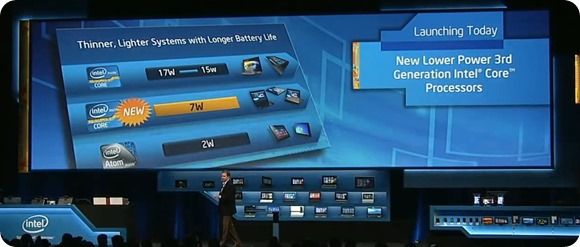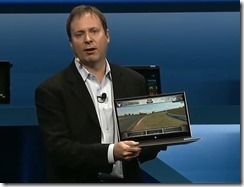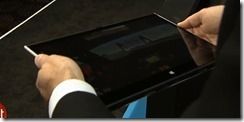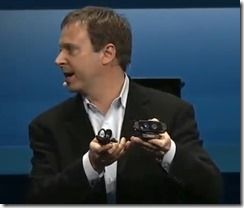Update: High quality video from the Intel CES 2013 press conference here.
Notes from the Intel Press Conference at CES. (Ultrabook-related only, for Bay Trail, see UMPCPortal)
Intel just announced the 7W TDP Core processors that we’ve been expecting. (see previous article)
It’s confirmed that the Lenovo Yoga 11S will use one of the new low-power CPUs. (See previous article)
On Ultrabooks though, Intel predict touch based systems at $599
The NEC Lavie 15” Ultrabook at less than 0.5”
“We’ve gone from inches to mm on this Journey”
Coming in 2013…
4th Generation Intel Core Ultrabooks are going to be game changers.
Haswell is first product designed from ground up with Ultrabooks in mind.
Natural interaction with touch and voice.
4th Gen Ultrabooks will have to have touch. Again, touch is mandatory to be a 4th gen Core Ultrabook.
Mandatory intel wireless display in 4th gen Core Ultrabooks.
Hawell Ref design shown. North Cape.
17mm Ultrabook. Batt in display and keyboard. 13hrs of battery life.
On perceptual computing (see this article) Intel announced progress.
Relationship expanding with Nuance.
“Face login” being implemented for secure login that uses 7-point and muscle movement detection
Developer kit shown that will also be available in retail.
Intel working to get these integrated into devices.
Million dollar developer competition progressing well.
Eye tracking demo was impressive.
Expect more about perceptual computing tomorrow.
We’ll obviously bring you more, if we haven’t already, soon. In the meantime, here’s the press release that accompanied the keynote…
Low Power Fuels Ultrabook Innovation
Since mid-2011, Intel has led the industry in enabling Ultrabook devices aimed at providing new, richer mobile computing experiences in thin, elegant and increasingly convertible and detachable designs. To enable these innovative designs, Intel announced last September that it added a new line of processors to its forthcoming 4th generation Intel Core processor family targeted at about 10 watt design power, while still delivering the excellent performance people want and need.
Skaugen announced today that the company is bringing the low-power line of processors into its existing 3rd generation Intel Core processor family. Available now, these chips will operate as low as 7 watts, allowing manufacturers greater flexibility in thinner, lighter convertible designs. Currently there are more than a dozen designs in development based on this new low-power offering and they are expected to enable a full PC experience in innovative mobile form factors including tablets and Ultrabook convertibles. The Lenovo IdeaPad Yoga* 11S Ultrabook and a future Ultrabook detachable from Acer will be among the first to market this spring based on the new Intel processors and were demonstrated by Skaugen on stage.
The 4th generation Intel Core processor family enables true all-day battery life — representing the most significant battery life capability improvement in Intel history. Skaugen disclosed that new systems are expected to deliver up to 9 hours of continuous battery life, freeing people from some of the wires and bulky power bricks typically toted around.
“The 4th generation Core processors are the first Intel chips built from the ground up with the Ultrabook in mind,” Skaugen said. “We expect the tremendous advancements in lower-power Core processors, and the significant ramp of touch-based systems will lead to a significant new wave of convertible Ultrabooks and tablets that are thinner, lighter and, at the same time, have the performance required for more human-like interaction such as touch, voice and gesture controls.”
To demonstrate the impact of the 4th generation Intel Core processor family, Skaugen showed a new form factor Ultrabook detachable reference design (codenamed “North Cape”) that converts into a 10mm tablet and can run on battery for up to 13 hours while docked.
Advancements made in the way consumers will interact with their computing devices were also demonstrated, including natural and more immersive interaction experiences using a 3-D depth camera. Intel showed applications running on an Ultrabook in which objects can be manipulated naturally with free movements of the hands, fingers, face and voice. One application that was demonstrated can be used for enabling new and immersive video collaboration and blogging experiences. These were all enabled using the Intel® Perceptual Computing SDK Beta. This year, Intel expects more Ultrabooks and all-in-one (AIO) systems to offer applications for voice control (Dragon Assistant*) andfacial recognition (Fast Access*) for convenience and freedom from passwords.
End of Press release.

















BRAVO, BRAVO! I have renewed confidence in the PC market if Intel can actually release this on time (Summer 2013).
Lower prices, longer battery life, ultra ultra thin and light form factors, high res screens, and MANDATORY WIRELESS DISPLAY OUT!! YES!
It’s like they’re actually listening.
I see little reason for cell phone processor based tablets when these arrive this summer. A good smart phone and a good convertible tablet with Haswell is exactly what I need and want. -Both a great tablet and a great PC experience in one device…
Hopefully this is enough to get some sales and a good app ecosystem built-out (which is the last piece of the puzzle).
This addresses so many of the short comings of PCs and highlights the short comings of tablets; it really makes the space between PCs and smart phones much smaller, shrinking the tablet pie.
Pricing is a big question; they need to not just create new lower margin products but they need to bring down the cost of the high-end devices that people want. If they can hit the right price point on the high end devices we could finally see some decent sales numbers again.
Adam
Although not noted here, Intel’s Clover Trail continues the move up market, encroaching on the lower powered Intel Core CPUs; ESPECIALLY in light that Intel Core CPUs are moving further down market.
The Z2580 is supposed to have both better performance and battery life, and of course WAY lower profit margins and costs than it’s Intel Core CPUs making it more and more of an option in the “just enough” computing world.
Adam
Sorry, they aren’t going to give up margins, so I guess you have to look elsewhere.
Oh what do you know they just announced a quad core Atom CPU, too “Bay Trail” http://www.engadget.com/2013/01/07/intel-atom-bay-trail/
A Bay Trail CPU in an x86 Win8 tablet sounds like a great, cheap Win8 tablet option! Gimmie gimmie!
Adam
Remove that link immediately, I reported it on UMCPortal.
http://www.umpcportal.com/2013/01/bay-trail-launched-at-ces-2013/
;-)
See my notes about Pentium and Celeron in the article too.
The Lenovo Yoga 11S is rated at 6 hours while Yoga 13 is rated at 8 hours. But that may not take into account idle states?
Lower TDP on the 11S won’t make a difference in battery life. It’s just there to make smaller form factors. TDP only makes a difference if you are doing something demanding.
Lower battery is likely because the 11S uses a smaller capacity battery than the 13.
That’s what I figured: smaller battery. Unfortunately not an improvement in this case. Hopefully we’ll see those up to 9 hours devices this year.
What about Haswell release date? Has it been really delayed? C’mon, Intel, just release it, stop pushing those power-hungry Ivy Bridge on us.
The Ultrabook parts were always bound for late Q2, early Q3. That’s no difference from second generation Ultrabooks that launched July of last year.
I really like that super thin bezel on the North Cape reference design with the optional virtual resizing from 13.3″ to 11.6″ in tablet mode. It’d be great if a version with an 11.6″ nominal screen size coupled with Sharp’s low power screen comes out.
Good thoughts! I love the virtual resizing too. Non-native resolution might not be as sharp though. Depends on the DPI and the users eyes!
Thanks to Steve for the quick and nice coverage!
Ultrabooks are quickly converging to tablets! What’s an ultrabook with touch and with removable keyboard? But in the tablet world 0.5 inches is too thick. iPad at 9.4mm is 3mm thinner! Let’s see what happens next…
It seems Intel pulled a fast one. The 7W was not TDP but “SDP”…
http://liliputing.com/2013/01/intels-new-low-power-ivy-bridge-chips-are-more-like-13w-processors-than-7w.html